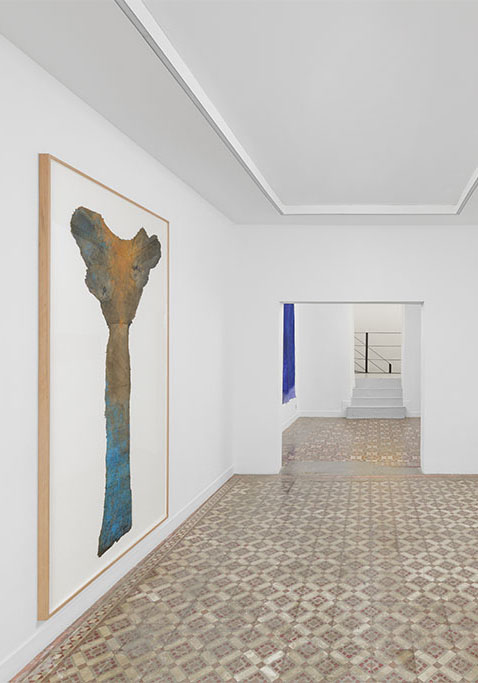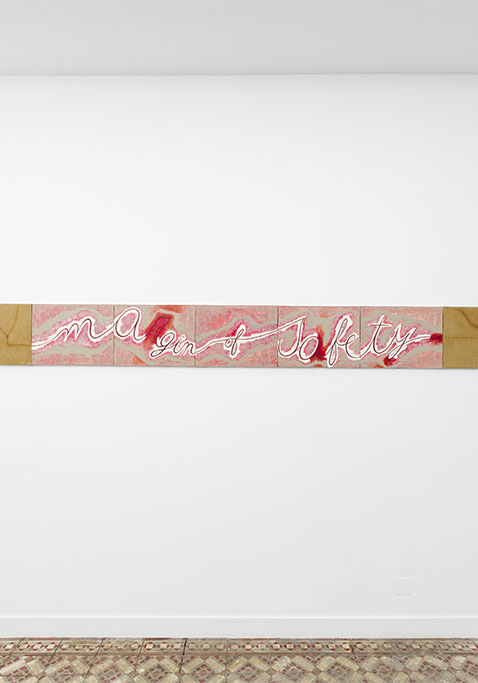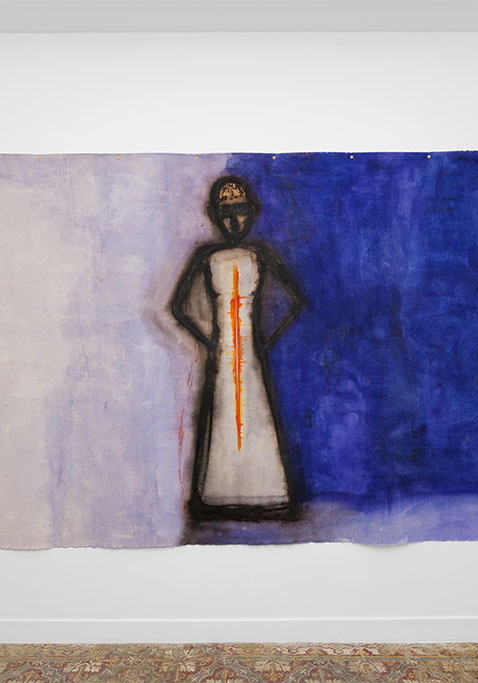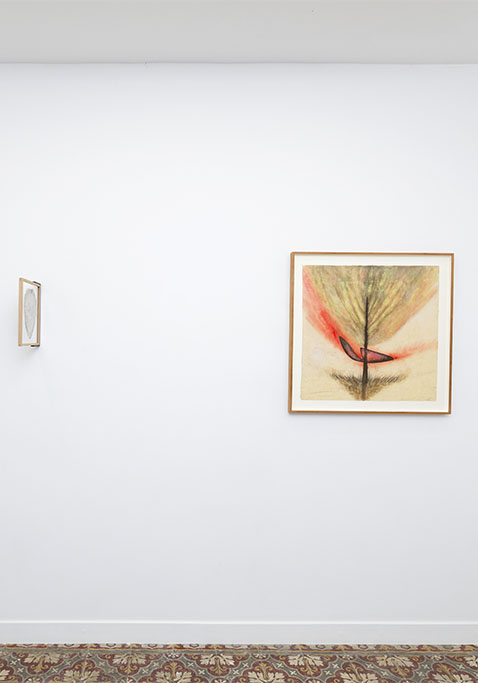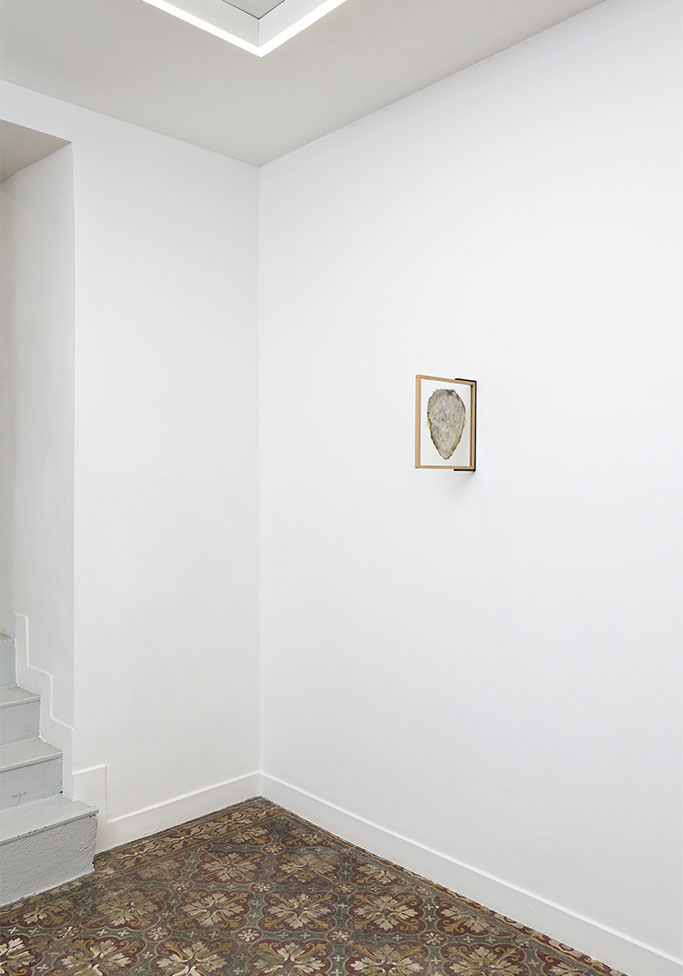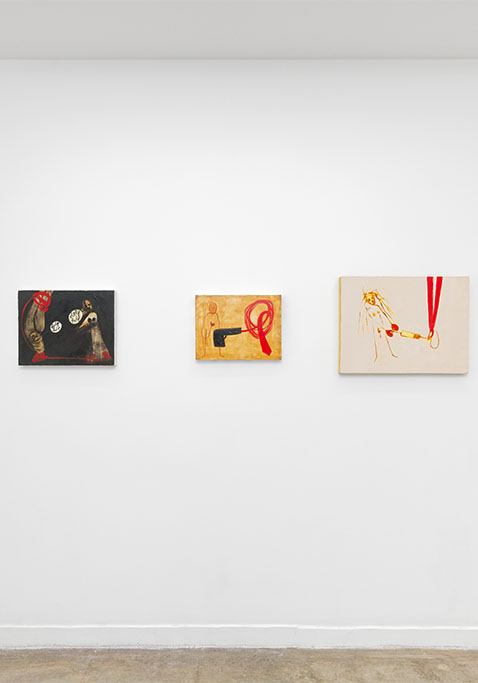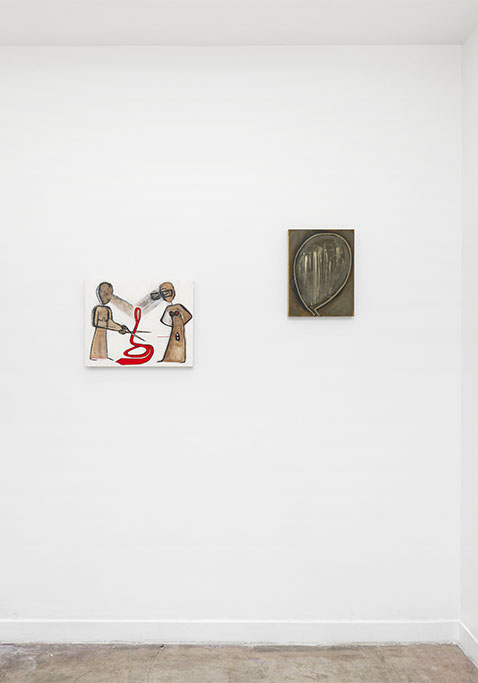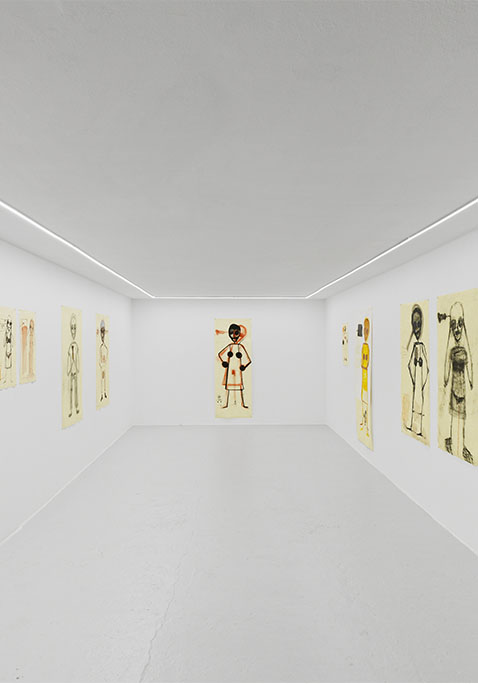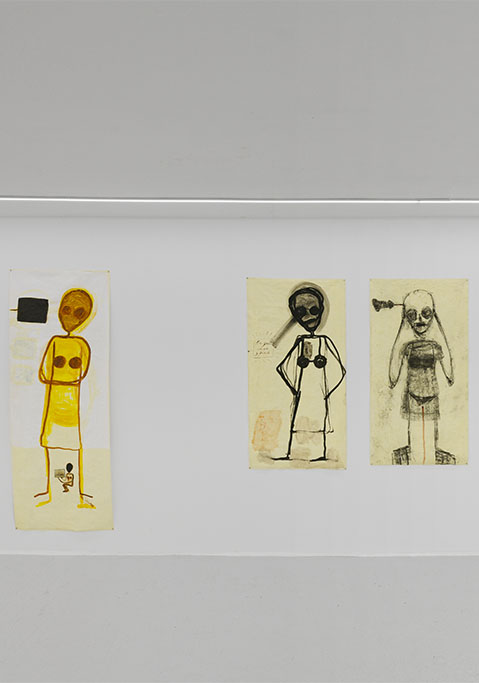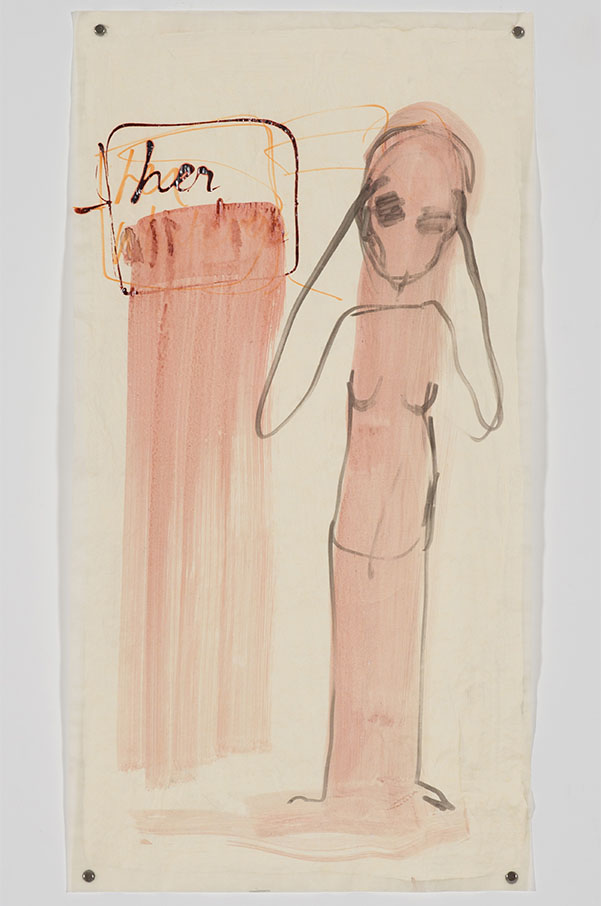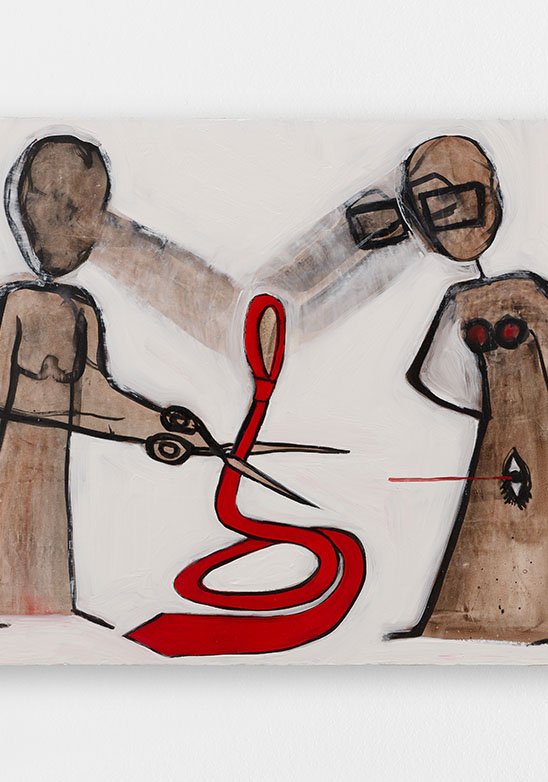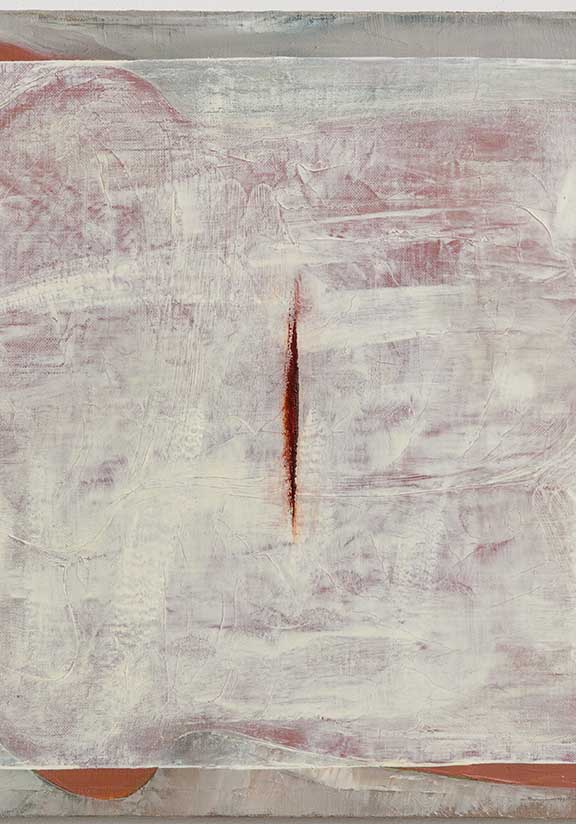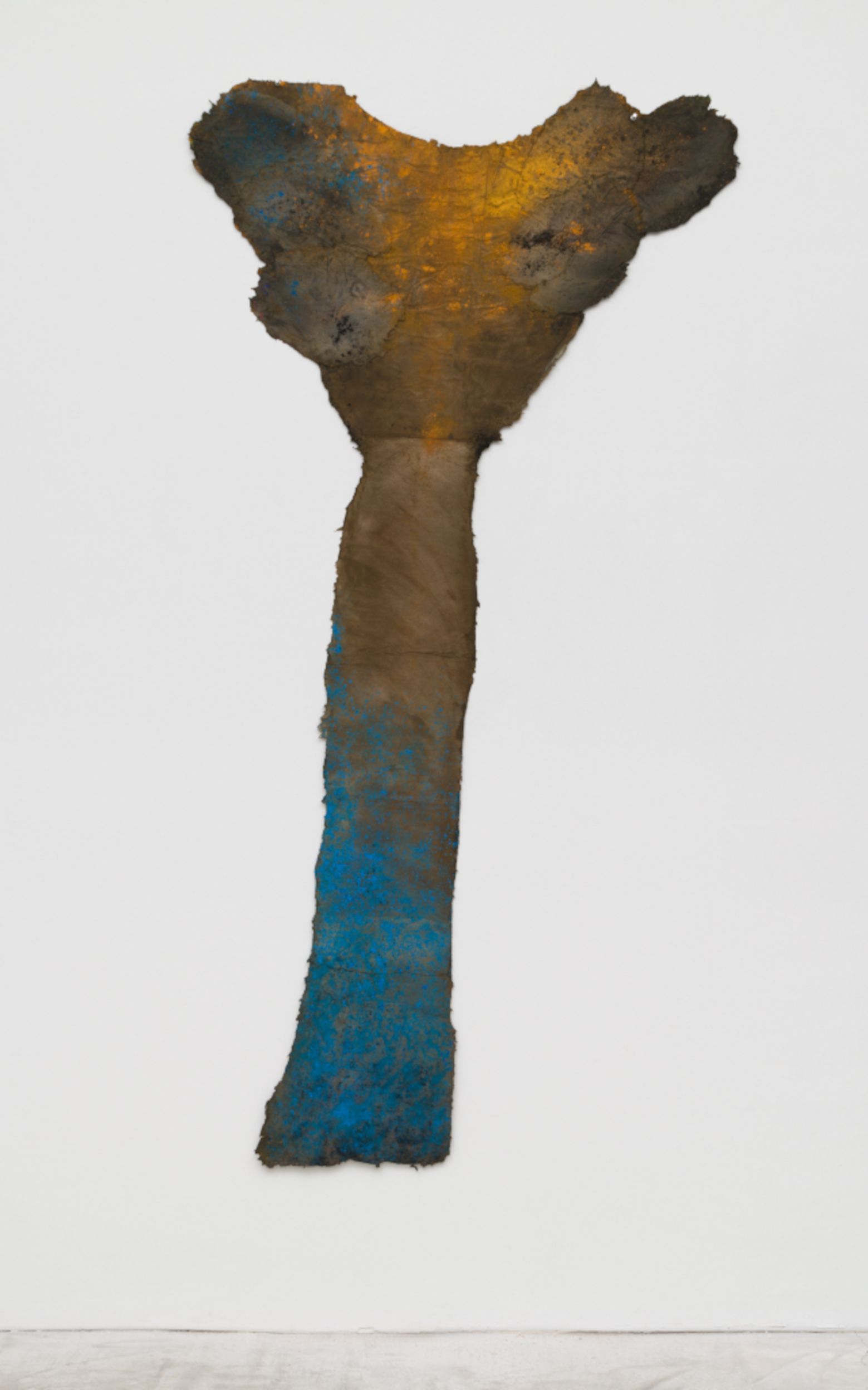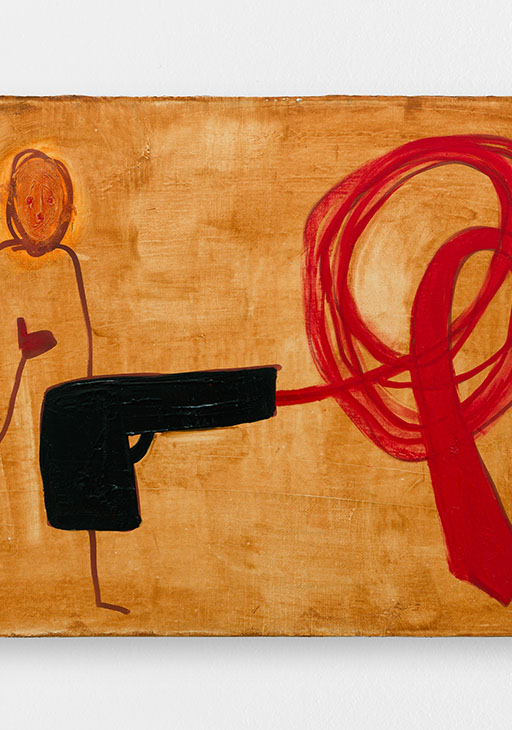
Margin of Safety
Mira Schor
14.03.2024 - 18.05.2024, vernissage 14.03.2024

en français plus bas
The second exhibition of an artist at the gallery brings with it a different joy than the first, which is entirely attached to the excitement of discovery. Today, it is more about reactivating the experience of visual pleasure and testing once again the thoughts and feelings that came along when in contact with the works. Living with them every day during the duration of a show allows us to confirm or refute certain intuitions in two simultaneous movements: we delve deeper into the artist's processes, and at the same time, this intimate knowledge enables us to develop our own relationship with the work, to understand "what it does to us."
Mira Schor's practice is exemplary in this regard. First because it has been accompanied for forty years by the artist's writings, a true guide toward a deep understanding of the work. And second, because it is entirely devoted to visual pleasure from a female perspective. Thus, it addresses both senses and mind, and "what it does to us" could not be more complete. If, by chance, we were not sensitive to the paintings on free canvas in the first exhibition at Marcelle Alix, the works on paper of the second show and its army of "Power Figures" installed in the same basement, will appeal to our need to find strong female figures of emancipation in contemporary representations. Those self-portraits as 'stick figures' find their counterpoints in the "Black paintings" of the last room: inspired by the diverse scandals of Donald Trump's presidency, they ridicule the attempts of the former US President to transform vain male attributes into signs of power.
IL: Isabelle, I love how you and Cécilia have curated your exhibition "Margin of Safety" and how it will further expand on the understanding of Mira’s oeuvre in Paris, Europe, and beyond. Beginning with a never before exhibited work from her first group of life-size Dresses (1975), her "Mask" series (1977) and "Margin of Safety" (1994) initially a part of her monumental "War Frieze" (1991-94), measuring 60 meters long, and culminating in her most recent free canvas "Torn" painting, I believe it will be a tour de force in material and formal complexity wedded with powerful reflections on the body, mortality, sexuality, patriarchy, and the continual looming threat of a Trump presidency. I love how your exhibition zooms into specific bodies of work, namely her "Power Figures" (2015-16) and "Black Paintings" (2017-18), and punctuates them with additional carefully curated works through her oeuvre. Mira’s continued engagement with painting as a medium to address power and our lived experience in all our vulnerability is evident in these two exhibitions. The connective tissue of the simultaneous exhibitions at Marcelle Alix and Lyles & King will be "Margin of Safety", a fellow "Torn" painting, an early “Dress,” and the "Masks". My hope is that the exhibition in New York will contextualize these works within her broader oeuvre as I’ve curated the exhibition with a focus on the poetical, bodily, and psychological strains in her work that I think have been overlooked due to the Mira’s radical political, feminist positions and her work as a writer. In our oversaturated world, Mira’s expansive oeuvre has been boxed in under her radical political agenda, but the atavistic, human, and poetic impact of her work comes from a more difficult to articulate interior world. Mira’s oeuvre contains multitudes. It articulates her life in manifold mediums with oscillations in representational strategies and relationship to language and the body. I think both of our exhibitions with present Mira’s work with a dynamism that hasn’t been experienced before. The coherence of her oeuvre and the single-mindedness of her mission is expressed with a virtuosic range of formal and material strategies.
CB: In 2022, during Mira Schor's first solo exhibition at the gallery, as she attentively and benevolently accompanied each of our hanging proposals, I had the feeling that something was happening that many imaginations hope for in a work: that it be a living reality, a tangible object that responds and speaks with us. After her return to New York, following the end of her exhibition, which we could have lived with for a long time without anything wearing out, something happened that had a concrete effect on me. What was alive, what gave me more energy and desire, was Mira Schor's talent for describing her inner life, the promises to be kept, and the enduring confrontation with a world where the emergence of dangerous and frightening things leads to breaking the silence daily. Mira Schor's painting is like an act of divination through the entrails, akin to that large free painting whose incised canvas opens the represented female body. If we are never immune to an internal explosion, the act of painting for Mira Schor is a way of showing oneself without reservation, like a formidable living body whose field of vision expands in length and depth, beyond a structural, historical, and aesthetic movement (which Mira analyzes so finely), primarily driven by new emotions. Her work seems to me to rest on an exchange of forces and energies that can be used to witness the advent of what each of us has in common, regardless of our experiences and our way of revisiting, through creation, political circumstances.
Born in 1950, Mira Schor is a New York-based painter and writer. Schor received her MFA in painting from CalArts in 1973. Schor’s work was shown in a solo show at Bourse de Commerce, Fondation Pinault (2024) and has also been included in exhibitions at June (2021), Kunsthaus Graz (2020), Kestner Gesellschaft (2019), The Jewish Museum (2010), Hammer Museum (1996) and P.S.1 (1992). She is the recipient of awards in painting from the Guggenheim, Rockefeller Foundation, Marie Walsh Sharpe, Pollock-Krasner Foundation and of the College Art Association’s Frank Jewett Mather Award in Art Criticism. She is the recipient of the 2019 Women’s Caucus for Art Lifetime Achievement Award for her work as a feminist painter, art historian and critic. She is represented by Lyles & King Gallery in New York City and Marcelle Alix in Paris.
Mira Schor's practice is exemplary in this regard. First because it has been accompanied for forty years by the artist's writings, a true guide toward a deep understanding of the work. And second, because it is entirely devoted to visual pleasure from a female perspective. Thus, it addresses both senses and mind, and "what it does to us" could not be more complete. If, by chance, we were not sensitive to the paintings on free canvas in the first exhibition at Marcelle Alix, the works on paper of the second show and its army of "Power Figures" installed in the same basement, will appeal to our need to find strong female figures of emancipation in contemporary representations. Those self-portraits as 'stick figures' find their counterpoints in the "Black paintings" of the last room: inspired by the diverse scandals of Donald Trump's presidency, they ridicule the attempts of the former US President to transform vain male attributes into signs of power.
IL: Isabelle, I love how you and Cécilia have curated your exhibition "Margin of Safety" and how it will further expand on the understanding of Mira’s oeuvre in Paris, Europe, and beyond. Beginning with a never before exhibited work from her first group of life-size Dresses (1975), her "Mask" series (1977) and "Margin of Safety" (1994) initially a part of her monumental "War Frieze" (1991-94), measuring 60 meters long, and culminating in her most recent free canvas "Torn" painting, I believe it will be a tour de force in material and formal complexity wedded with powerful reflections on the body, mortality, sexuality, patriarchy, and the continual looming threat of a Trump presidency. I love how your exhibition zooms into specific bodies of work, namely her "Power Figures" (2015-16) and "Black Paintings" (2017-18), and punctuates them with additional carefully curated works through her oeuvre. Mira’s continued engagement with painting as a medium to address power and our lived experience in all our vulnerability is evident in these two exhibitions. The connective tissue of the simultaneous exhibitions at Marcelle Alix and Lyles & King will be "Margin of Safety", a fellow "Torn" painting, an early “Dress,” and the "Masks". My hope is that the exhibition in New York will contextualize these works within her broader oeuvre as I’ve curated the exhibition with a focus on the poetical, bodily, and psychological strains in her work that I think have been overlooked due to the Mira’s radical political, feminist positions and her work as a writer. In our oversaturated world, Mira’s expansive oeuvre has been boxed in under her radical political agenda, but the atavistic, human, and poetic impact of her work comes from a more difficult to articulate interior world. Mira’s oeuvre contains multitudes. It articulates her life in manifold mediums with oscillations in representational strategies and relationship to language and the body. I think both of our exhibitions with present Mira’s work with a dynamism that hasn’t been experienced before. The coherence of her oeuvre and the single-mindedness of her mission is expressed with a virtuosic range of formal and material strategies.
CB: In 2022, during Mira Schor's first solo exhibition at the gallery, as she attentively and benevolently accompanied each of our hanging proposals, I had the feeling that something was happening that many imaginations hope for in a work: that it be a living reality, a tangible object that responds and speaks with us. After her return to New York, following the end of her exhibition, which we could have lived with for a long time without anything wearing out, something happened that had a concrete effect on me. What was alive, what gave me more energy and desire, was Mira Schor's talent for describing her inner life, the promises to be kept, and the enduring confrontation with a world where the emergence of dangerous and frightening things leads to breaking the silence daily. Mira Schor's painting is like an act of divination through the entrails, akin to that large free painting whose incised canvas opens the represented female body. If we are never immune to an internal explosion, the act of painting for Mira Schor is a way of showing oneself without reservation, like a formidable living body whose field of vision expands in length and depth, beyond a structural, historical, and aesthetic movement (which Mira analyzes so finely), primarily driven by new emotions. Her work seems to me to rest on an exchange of forces and energies that can be used to witness the advent of what each of us has in common, regardless of our experiences and our way of revisiting, through creation, political circumstances.
Born in 1950, Mira Schor is a New York-based painter and writer. Schor received her MFA in painting from CalArts in 1973. Schor’s work was shown in a solo show at Bourse de Commerce, Fondation Pinault (2024) and has also been included in exhibitions at June (2021), Kunsthaus Graz (2020), Kestner Gesellschaft (2019), The Jewish Museum (2010), Hammer Museum (1996) and P.S.1 (1992). She is the recipient of awards in painting from the Guggenheim, Rockefeller Foundation, Marie Walsh Sharpe, Pollock-Krasner Foundation and of the College Art Association’s Frank Jewett Mather Award in Art Criticism. She is the recipient of the 2019 Women’s Caucus for Art Lifetime Achievement Award for her work as a feminist painter, art historian and critic.?She is represented by Lyles & King Gallery in New York City and Marcelle Alix in Paris.
Warmest thanks to: Clotilde Beautru, Kate Gerard, Romain Grateau, Esteban Neveu, Chloé Poulain, Louise Toth, Josselin Vidalenc and the Lyles & King team: Ali Bonfils, Isaac Lyles et Allyson Pinon.
-
La deuxième exposition d’un·e artiste à la galerie porte avec elle une joie différente de la première qui est toute entière attachée à l’excitation de la découverte : aujourd’hui, il s’agit plutôt de réactiver un plaisir visuel déjà éprouvé et de tester à nouveau les réflexions que nous nous étions faites au contact des œuvres. Vivre avec elles tous les jours pendant la durée d’une exposition nous permet de confirmer ou d’infirmer certaines intuitions en deux mouvements simultanés : nous pénétrons plus profondément les processus de l’artiste et en même temps, cette connaissance intime nous permet de développer notre propre rapport au travail, de comprendre « ce qu’il nous fait ».
IA : Le travail de Mira Schor est exemplaire à ce titre, parce qu’il s’accompagne d’une pensée publiée par l’artiste depuis une quarantaine d’année qui nous guide vers la compréhension intime des œuvres, mais aussi parce qu’il est tout entier voué au plaisir visuel à partir du point de vue d’une femme. Il s’adresse ainsi à la fois aux sens et à l’esprit et « ce qu’il nous fait » ne pourrait être plus entier. Si par hasard nous n’étions pas sensibles aux toiles libres de la première exposition, le travail sur papier de la deuxième et son armée de « Power Figures » installée au sous-sol, saura s’adresser à notre besoin de trouver puissance et figures d’émancipation dans les représentations contemporaines. Ces autoportraits en « figures stylisées » trouvent leur contrepartie dans les « Peintures noires » de la dernière salle de l’exposition. Inspirées par les différents scandales de la présidence de Donald Trump, elles tournent en ridicule les tentatives de l’ancien Président des Etats-Unis de transformer de vulgaires signes de masculinité toxique en signes de pouvoir.
IL : Isabelle, j'admire la façon dont toi et Cécilia avez organisé votre exposition « Margin of Safety » et la manière dont elle contribuera à approfondir la compréhension de l'œuvre de Mira à Paris, en Europe et au-delà. En commençant par des œuvres jamais exposées auparavant de sa première série « Dress » (1975) « Mask » (1977) et « Margin of Safety » (1994) qui faisait initialement partie de la monumentale « War Frieze » (1991-94), mesurant 60 mètres de long, et en l’achevant par sa toile la plus récente intitulée « Torn », je crois que cela sera un tour de force en termes de complexité matérielle et formelle, couplé à de puissantes réflexions sur le corps, la mortalité, la sexualité, le patriarcat et la menace persistante d'une présidence de Trump. J'apprécie la manière dont votre exposition se concentre sur des corpus spécifiques, notamment les « Power Figures » (2015-16) et les « Black Paintings » (2017-18) pour les associer à d'autres œuvres soigneusement choisies à travers son œuvre. L'engagement continu de Mira envers la peinture en tant que moyen d'aborder le pouvoir et notre expérience vécue dans toute sa vulnérabilité est évident dans ces deux expositions.
Plusieurs œuvres font le lien entre les deux expositions simultanées chez Marcelle Alix et Lyles & King : « Margin of Safety », « Torn » et la série des masques. Mon espoir est que l'exposition de New York contextualisera ces œuvres dans le cadre de son œuvre plus vaste, car je l’ai pensée en mettant l'accent sur les aspects poétiques, corporels et psychologiques de son travail que je pense avoir été négligés en raison des positions politiques et féministes radicales de Mira, ainsi que de son travail en tant qu'écrivaine. Dans notre monde saturé, l'œuvre étendue de Mira a été reléguée en-deçà de son travail d’autrice, mais l'impact atavique, humain et poétique de son œuvre plastique provient d'un monde intérieur plus difficile à articuler. L'œuvre de Mira contient des multitudes. Elle articule sa vie à travers de multiples médiums avec des oscillations nuancées dans les stratégies de représentation et dans sa relation au langage et au corps. Je pense que nos deux expositions présenteront le travail de Mira dans une dynamique qui n’a pas encore été expérimentée. La cohérence de son œuvre et la détermination dont elle fait preuve dans la mission qu’elle se donne s'expriment avec une gamme virtuose de stratégies formelles et matérielles.
CB: En 2022, lors de la première exposition personnelle de Mira Schor à la galerie, alors qu'elle accompagnait chacune de nos propositions d'accrochage avec attention et bienveillance, j'eus le sentiment que se produisait ce que bien des imaginaires espèrent d'une œuvre: quelle soit une réalité vivante, un objet tangible qui nous réponde et parle avec nous. Après son retour à New York, après la fin de son exposition avec laquelle nous aurions pu vivre longtemps sans que rien ne s'use, quelque chose advint qui a eu un effet concret sur moi. Ce qui était vivant, ce qui me donnait plus d'énergie et plus d'envie, c'était ce talent de Mira Schor pour décrire sa vie intérieure, les promesses à tenir et la confrontation durable avec un monde où le surgissement de choses dangereuses et effrayantes entraînent à rompre le silence quotidiennement. La peinture de Mira Schor est comme un acte de divination par les entrailles, à l'image de cette grande peinture libre dont la toile incisée ouvre le corps féminin représenté. Si nous ne sommes jamais à l'abri d'une déflagration intérieure, l'acte de peindre chez Mira Schor est une manière de se montrer sans complexe, tel un formidable corps vivant dont le champ de vision s'élargit en longueur et en profondeur, hors d'un mouvement structural, historique et esthétique (que Mira analyse si finement), avant tout poussé par des émotions neuves. Son travail me semble reposer sur un échange de forces et d'énergies dont on peut profiter pour voir l'avènement de ce que chacun de nous a en propre, quel que soit notre vécu et notre manière de revisiter, par la création, les circonstances politiques.
Née en 1950, Mira Schor est une peintre et autrice new-yorkaise. Elle est diplômée du California Institute of the Arts en 1973. Son travail a été présenté dans une exposition personnelle à la Bourse de Commerce de la Fondation Pinault (2024) et dans des expositions collectives à June (2021), Kunsthaus Graz (2020), Kestner Gesellschaft (2019), The Jewish Museum (2010), Hammer Museum (1996) et P.S.1 (1992). Elle a reçu plusieurs prix pour son travail de peinture de la part d’institutions telles que le Guggenheim, Rockefeller Foundation, Marie Walsh Sharpe, Pollock-Krasner Foundation et a reçu le prix Frank Jewett Mather de la part du College Art Association pour ses écrits sur l’art. En 2019, elle obtient le prix Lifetime Achievement de la part de l’association Women’s Caucus for Art pour l’ensemble de sa carrière d’artiste féministe, historienne de l’art et critique. Mira Schor est représentée par Lyles & King à New York et Marcelle Alix à Paris.
Remerciements chaleureux à : Clotilde Beautru, Kate Gerard, Romain Grateau, Esteban Neveu, Chloé Poulain, Louise Toth, Josselin Vidalenc et l'équipe de Lyles & King: Ali Bonfils, Isaac Lyles et Allyson Pinon.


